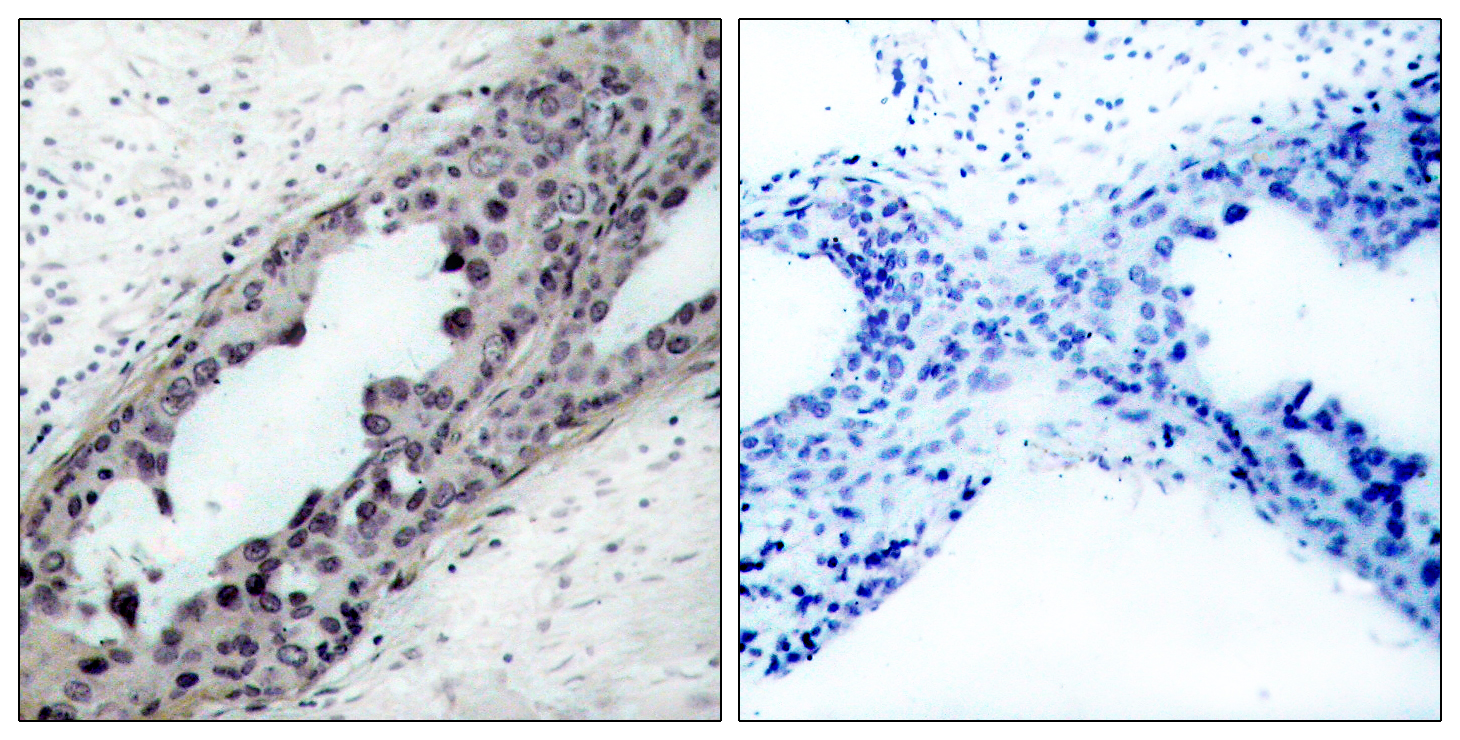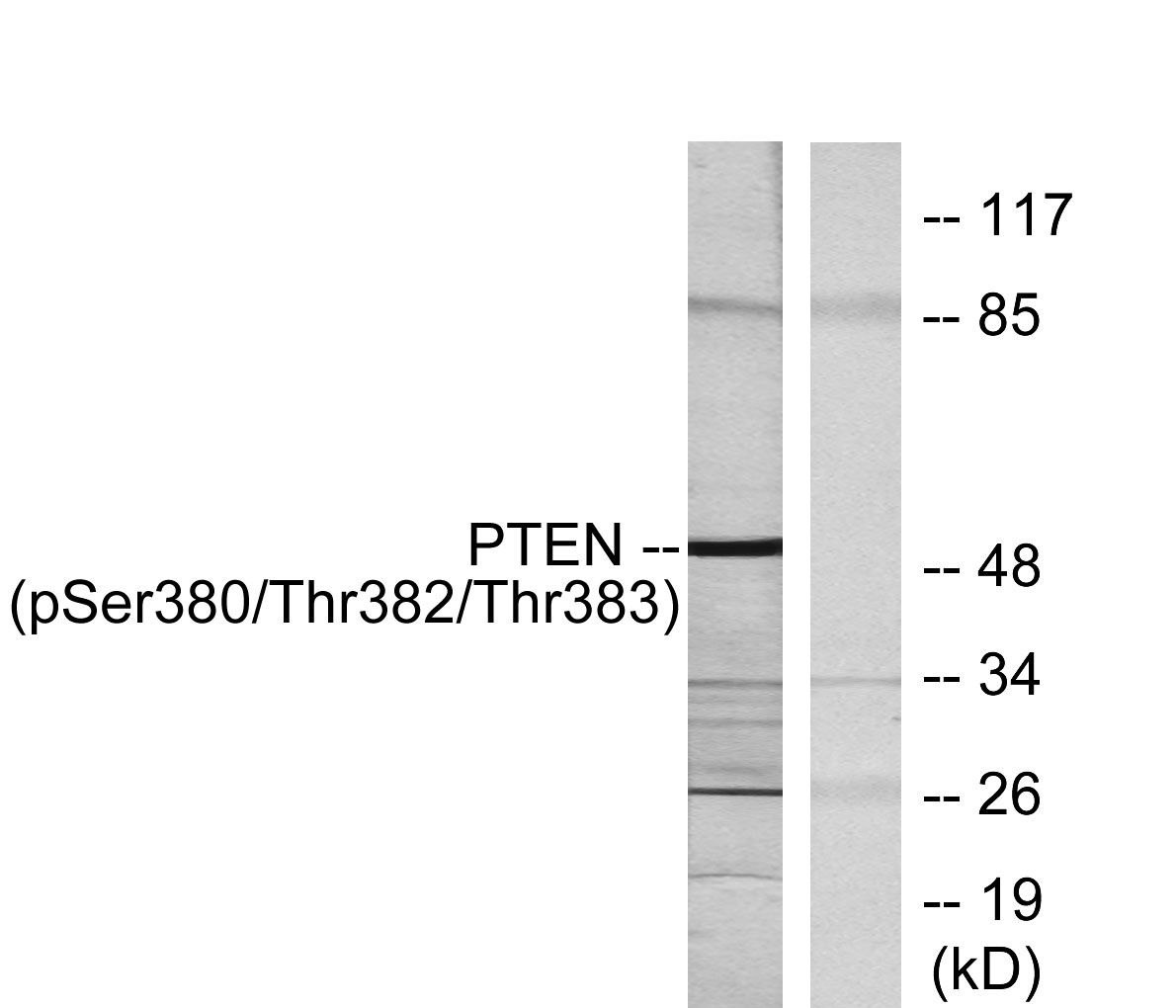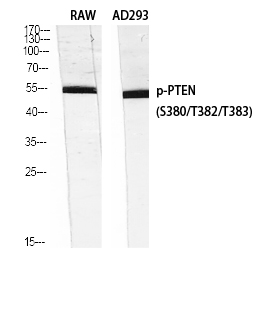PTEN (phospho Ser380/T382/T383) Rabbit Polyclonal Antibody
产品基本信息

Immunohistochemistry analysis of paraffin-embedded human breast cancer, using PTEN (Phospho-Ser380/Thr382/Thr383) Antibody. The picture on the right is blocked with the PTEN (Phospho-Ser380/Thr382/Thr383) peptide.

Western blot analysis of PTEN (Phospho-Ser380/Thr382/Thr383) Antibody. The lane on the right is blocked with the PTEN (Phospho-Ser380/Thr382/Thr383) peptide.
polbd-p-ihc-human-uterus-cancer.jpg)
Immunohistochemical analysis of paraffin-embedded Human-uterus-cancer tissue. 1,PTEN (phospho Ser380/T382/T383) Polyclonal Antibody was diluted at 1:200(4°C,overnight). 2, Sodium citrate pH 6.0 was used for antibody retrieval(>98°C,20min). 3,Secondary antibody was diluted at 1:200(room tempeRature, 30min). Negative control was used by secondary antibody only.
polbd-p-ihc-human-tonsil.jpg)
Immunohistochemical analysis of paraffin-embedded Human-Tonsil tissue. 1,PTEN (phospho Ser380/T382/T383) Polyclonal Antibody was diluted at 1:200(4°C,overnight). 2, Sodium citrate pH 6.0 was used for antibody retrieval(>98°C,20min). 3,Secondary antibody was diluted at 1:200(room tempeRature, 30min). Negative control was used by secondary antibody only.
polbd-p-ihc-human-colon.jpg)
Immunohistochemical analysis of paraffin-embedded Human-colon tissue. 1,PTEN (phospho Ser380/T382/T383) Polyclonal Antibody was diluted at 1:200(4°C,overnight). 2, Sodium citrate pH 6.0 was used for antibody retrieval(>98°C,20min). 3,Secondary antibody was diluted at 1:200(room tempeRature, 30min). Negative control was used by secondary antibody only.
polbd-p-ihc-human-lung.jpg)
Immunohistochemical analysis of paraffin-embedded Human-lung tissue. 1,PTEN (phospho Ser380/T382/T383) Polyclonal Antibody was diluted at 1:200(4°C,overnight). 2, Sodium citrate pH 6.0 was used for antibody retrieval(>98°C,20min). 3,Secondary antibody was diluted at 1:200(room tempeRature, 30min). Negative control was used by secondary antibody only.
polbd-p-ihc-human-lung-cancer.jpg)
Immunohistochemical analysis of paraffin-embedded Human-lung-cancer tissue. 1,PTEN (phospho Ser380/T382/T383) Polyclonal Antibody was diluted at 1:200(4°C,overnight). 2, Sodium citrate pH 6.0 was used for antibody retrieval(>98°C,20min). 3,Secondary antibody was diluted at 1:200(room tempeRature, 30min). Negative control was used by secondary antibody only.
polbd-p-ihc-human-appendix.jpg)
Immunohistochemical analysis of paraffin-embedded Human-Appendix tissue. 1,PTEN (phospho Ser380/T382/T383) Polyclonal Antibody was diluted at 1:200(4°C,overnight). 2, Sodium citrate pH 6.0 was used for antibody retrieval(>98°C,20min). 3,Secondary antibody was diluted at 1:200(room tempeRature, 30min). Negative control was used by secondary antibody only.
polbd-p-ihc-rat-brain.jpg)
Immunohistochemical analysis of paraffin-embedded Rat-brain tissue. 1,PTEN (phospho Ser380/T382/T383) Polyclonal Antibody was diluted at 1:200(4°C,overnight). 2, Sodium citrate pH 6.0 was used for antibody retrieval(>98°C,20min). 3,Secondary antibody was diluted at 1:200(room tempeRature, 30min). Negative control was used by secondary antibody only.
polbd-p-ihc-rat-spleen.jpg)
Immunohistochemical analysis of paraffin-embedded Rat-spleen tissue. 1,PTEN (phospho Ser380/T382/T383) Polyclonal Antibody was diluted at 1:200(4°C,overnight). 2, Sodium citrate pH 6.0 was used for antibody retrieval(>98°C,20min). 3,Secondary antibody was diluted at 1:200(room tempeRature, 30min). Negative control was used by secondary antibody only.
polbd-p-ihc-mouse-lung.jpg)
Immunohistochemical analysis of paraffin-embedded Mouse-lung tissue. 1,PTEN (phospho Ser380/T382/T383) Polyclonal Antibody was diluted at 1:200(4°C,overnight). 2, Sodium citrate pH 6.0 was used for antibody retrieval(>98°C,20min). 3,Secondary antibody was diluted at 1:200(room tempeRature, 30min). Negative control was used by secondary antibody only.
polbd-p-ihc-mouse-spleen.jpg)
Immunohistochemical analysis of paraffin-embedded Mouse-spleen tissue. 1,PTEN (phospho Ser380/T382/T383) Polyclonal Antibody was diluted at 1:200(4°C,overnight). 2, Sodium citrate pH 6.0 was used for antibody retrieval(>98°C,20min). 3,Secondary antibody was diluted at 1:200(room tempeRature, 30min). Negative control was used by secondary antibody only.

Western Blot analysis of RAW AD293 using Phospho-PTEN (S380/T382/T383) Polyclonal Antibody diluted at 1:1000
相关文献
产品问答
相关产品

市场:027-65023363 行政/人事:027-62439686 邮箱:marketing@brainvta.com 客服:18140661572(活动咨询、售后反馈等)
销售总监:张经理 18995532642 华东区:陈经理 18013970337 华南区:王经理 13100653525 华中/西区:杨经理 18186518905 华北区:张经理 18893721749
地址:中国武汉东湖高新区光谷七路128号中科开物产业园1号楼
Copyright © 武汉枢密脑科学技术有限公司. All RIGHTS RESERVED.
鄂ICP备2021009124号 DIGITAL BY VTHINK